Jupiter the Gas Giant
by: Yuen Tai Chan & Fatima Chaudhry

Jupiter was named after the Roman King of the Gods. Jupiter is the fifth planet from the Sun and is also the largest planet in our Solar System. It is one of the four gas planets, or gas giants. Jupiter is over two times as massive as all of the planets combined and is the second brightest planet in the sky. Jupiter travels around the Sun in an elliptical orbit and it takes Jupiter about 4,333 Earth days to complete an orbit around the Sun. As Jupiter travels around the Sun it also rotates on its axis. Jupiter, unlike all other planets, rotates relatively fast; it takes Jupiter 9 hours and 56 minutes to complete 1 rotation on its axis. In terms of mass, Jupiter’s mass is about 318 times greater than that of Earth’s. However Jupiter’s density is about 1.33 grams per cubic centimeters which is only 1/4 of Earth’s density. This led scientist to believe that Jupiter is made up of mostly helium and hydrogen.
Jupiter Statistics
|
| Mass (kg) |
1.900e+27 |
| Mass (Earth = 1) |
3.1794e+02 |
| Equatorial radius (km) |
71,492 |
| Equatorial radius (Earth = 1) |
1.1209e+01 |
| Mean density (gm/cm^3) |
1.33 |
| Mean distance from the Sun (km) |
778,330,000 |
| Mean distance from the Sun (Earth = 1) |
5.2028 |
| Rotational period (days) |
0.41354 |
| Orbital period (days) |
4332.71 |
| Mean orbital velocity (km/sec) |
13.07 |
| Orbital eccentricity |
0.0483 |
| Tilt of axis (degrees) |
3.13 |
| Orbital inclination (degrees) |
1.308 |
| Equatorial surface gravity (m/sec^2) |
22.88 |
| Equatorial escape velocity (km/sec) |
59.56 |
| Visual geometric albedo |
0.52 |
| Magnitude (Vo) |
-2.70 |
| Mean cloud temperature |
-121°C |
| Atmospheric pressure (bars) |
0.7 |
| Atmospheric composition
|
90%
10% |
Atmosphere
The atmosphere of Jupiter is composed of 86% hydrogen and 14% of helium, and very small amount of methane, ammonia, phosphine, water, acetylene, ethane, germanium, and carbon monoxide. There is believed to be greater amounts of water on Jupiter because of the lightning activity, but there is no substantial evidence. There is no distinction between where the gaseous atmosphere ends and the liquid hydrogen core begins.
Cloud Bands
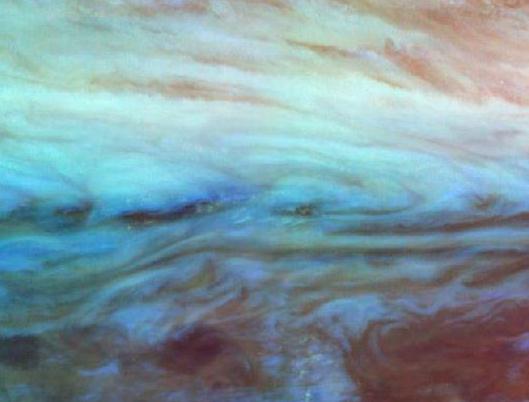
Jupiter is covered by cloud bands composed of ammonia crystals and ammonium hydrosulfide. From these bands, we are able to distinguish its rapid speed. The cloud layer is about 50 km deep and it is probable that there is a layer of water clouds under it. Its speed of rotation and liquid interior give Jupiter a certain degree of flatness, or oblateness.

Special Physical Features: The Giant Red Spot
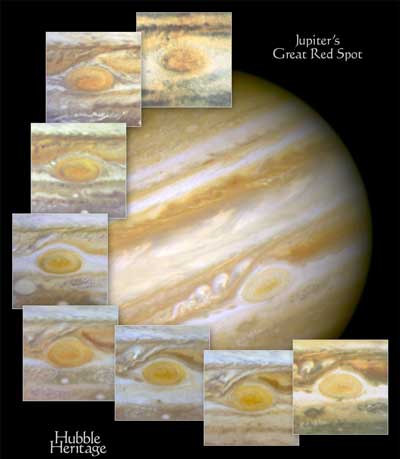
Jupiter’s most distinguished physical feature is the Great Red Spot. As the name suggests, it is a giant red spot on Jupiter’s surface. The Great Red Spot resembles a hurricane because the gases are swirling as it drift east and west. It is in fact an anticyclone present in a high pressure system which separates it from the low pressure system storms found on Earth. The length of the widest diameter of the Great Red Spot is three times larger than the diameter of Earth. Like the Great Red Spot, there are other, smaller, storms present on Jupiter which can last anywhere from a couple of hours to centuries.
Extreme Temperatures
Jupiter have extreme temperatures, at the top of its clouds, is about -230°F, as you move past the clouds its temperature increases to about 70°F, but when u move toward the core of Jupiter, the temperature reach a shocking 43,000°F which is hotter than the surface of the sun.
Rings
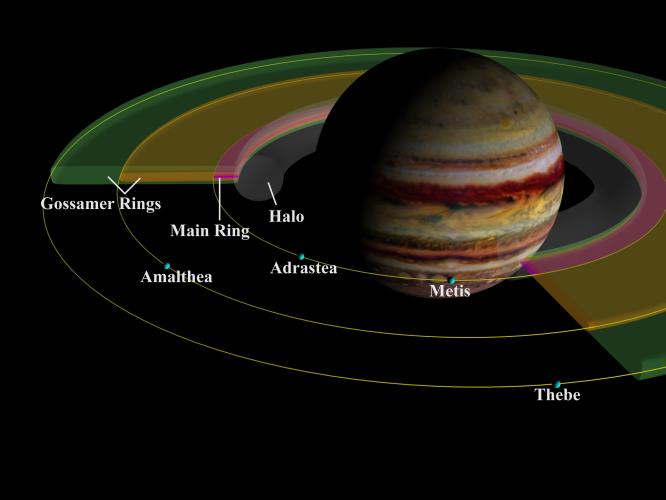
Jupiter has 3 thin rings: a halo and two gossamer rings. Compared to Saturn’s rings they are much fainter. Jupiter’s rings are composed of dust particles from its satellites as opposed to ice in Saturn's case.
Satellites

Jupiter has 63 moons (49 of which are officially named), many of which are probably asteroids captured by Jupiter’s gravity. The 4 largest moons are also known as Galilean moons, named after their discoverer Galileo. They are Io, Europa, Ganymede, and Callisto.
Io
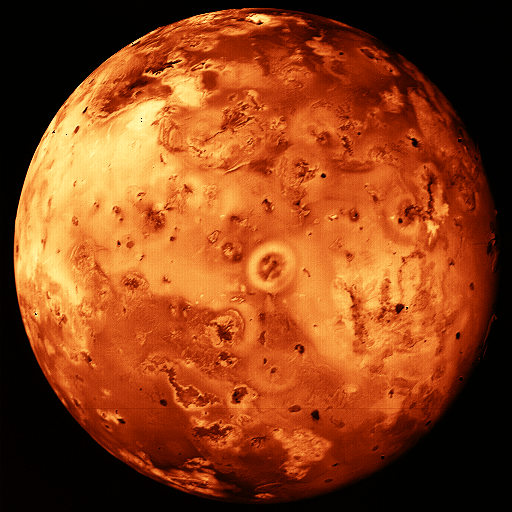
Io is the fifth satellite from Jupiter, but is the closest of the Galilean moons, and is the 3rd largest of the moons. It is bigger than Earth’s moon and is the most volcanically active in the solar system. Jupiter’s gravity causes ‘tides’ on Io to rise up to 100 meters. The surface of Io is covered in sulfur. It travels around Jupiter in an elliptical orbit.
Europa

Europa’s surface is ice and is thought to be covering an ocean. It is about the size of Earth’s moon. Since Europa is close to Jupiter, it gets hit by meteorites more frequently but its active surface manages to wipe off signs of any hits as soon as they happen. It has no magnetic field of its own and runs on tidal heating. In comparison to the other Galilean moons, Europa is relatively young.
Ganymede

Ganymede is both Jupiter’s and the entire Solar System’s largest moon. Its core is most likely made of rock (possibly iron), its mantle of water and ice, and its crust of rock and ice. It doesn’t have a known atmosphere but a possible ozone layer has been detected. On its surface one can find mountains, valleys, lava flows, and craters. Some of the surface seems old and cratered but a good percentage contains less craters and seems newer. This can be because of a water flood resulting from cracked ice on the surface.
Callisto

Callisto is the furthest of the 4 Galilean moons and the third largest satellite in the solar system. The same side is always facing Jupiter because it is tidally locked. Like Ganymede and Europa, it is composed of rock and ice. The rock and ice is equally present in the moon, but the outer 10 km is all ice. It is heavily cratered and since it has shown no activity, it is thought to be dead.
Comet Impact

•On July 16-22 1994, over 20 pieces from the comet P/Shoemaker–Levy 9 collided with Jupiter at 60 km/s.

Latest Research
• A simulation by the University of California shows that Jupiter’s core might be 2 times bigger and icier than originally thought.
• It has been hypothesized that if Jupiter’s moon Europa had a tilted axis, gravitational pull from Jupiter could create waves in Europa’s ocean.
•After observing Red Spot Junior, a Planetary Science Group of the University of the Basque Country in Spain noticed that in just a few months, the color changed from white to red. This was probably because of the diffusion of a compound or vapor that mixed with solar photons in the upper level of Red Spot Jr.
Experiments
Experiment I: Send a spacecraft to Jupiter in order to find out more about the core
Recently there have simulations proposing a new theory about Jupiter’s core in which the core is much more massive than originally thought, composed of heavy rock and metals. This rocky core is then thought to be covered by a layer of ice above which is an atmosphere of hydrogen and helium. This theory is very different from the one that we have been using for so long now.
We can send a spacecraft covered with a material that will be able to withstand very high temperatures on Jupiter and will allow it to move smoothly in orbit around Jupiter. Many of the instruments that will be part of the spacecraft will be very similar to those used on the Galileo spacecraft in 1989, only superior. Solar panels and radioisotope thermmoelectric generators can be used to power it. Spectrometers, magnetometers, interferometers, and radiometers can be used to observe atmoshpheric and magnetic properties. We will have the spacecraft measure heat radiation from Jupiter’s atmosphere which will give more information on the composition of its atmosphere and core. For example, by finding out ratios of certain elements present in the atmosphere, we can find out for sure how much water and, as a result, oxygen, there actually is in the atmosphere.
Experiment II: Send a probe into the Great Red Spot, or any other anticyclone
One of the biggest physical characteristics of Jupiter is the Great Red Spot which is a high pressure anticyclone unlike the low pressure storms that we have on Earth. Like the GRS, there are many anticyclone systems on Jupiter, and the amazing part is that they are able to last for centuries. GRS itself has lasted over 300 years. Not too long ago there was a change in Red Spot Junior from a white color to a red color, but no one has been able to attribute the change to anything.
We can send a probe into the GRS, or any other high pressure system present on Jupiter in order to see what makes them so persistent. This probe would have to be able to withstand the temperatures on Jupiter and the speed of the storms themselves while being able to get decent information. It will be covered in a thick heat shield of carbon phenolic which will protect it from the high critical temperature and pressure. It will have particle detectors, a radar, and camera that would be able to take photos under the proposed conditions of an anticyclone and would be able to gather samples or measure aspects such as wind speed, composition, etc.
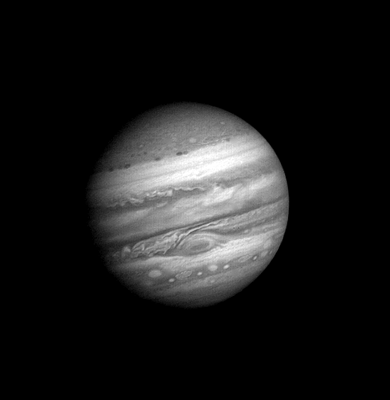
---------------------------------------------------------------------------------------------------------------
Sources:
http://www.nasa.gov/worldbook/jupiter_worldbook.html
http://www.nineplanets.org/jupiter.html
http://www.solarviews.com/eng/jupiter.htm
http://en.wikipedia.org/wiki/Jupiter
http://www.solarviews.com/eng/impact.htm
http://www.sciencedaily.com/releases/2008/11/081125132520.htm
http://www.sciencedaily.com/releases/2008/09/080922100452.htm
http://www.sciencedaily.com/releases/2008/12/081212092056.htm
Images Sources:
http://www.mallorcaweb.net/masm/Planetas/Jupiter.jpg
http://apod.nasa.gov/apod/image/9703/beltzone_gal.jpg
http://upload.wikimedia.org/wikipedia/commons/7/76/PIA02863_-_Jupiter_surface_motion_animation.gif
http://images.astronet.ru/pubd/2006/11/14/0001217802/redspot_heritage.jpg
http://photojournal.jpl.nasa.gov/jpegMod/PIA01627_modest.jpg
http://www.europa.astrowww.pl/obrazki/1.jpg
http://starchild.gsfc.nasa.gov/Images/StarChild/solar_system_level2/io_big.gif
http://www.wwu.edu/depts/skywise/planets/europa.jpg
http://www.spacetoday.org/images/SolSys/Jupiter/Ganymede.jpg
http://www.onlyscreensavers.com/ss/onst.jpg
http://www2.jpl.nasa.gov/sl9/gif/sl9_home.gif
http://photojournal.jpl.nasa.gov/browse/PIA02855.gif
Video Source:
http://www.youtube.com/watch?v=-Nc9D-pCPao
Comments (3)
Artemis rafti said
at 8:09 pm on Jan 9, 2009
Amazing job. Information was very informative yet readbale and somewhat brief (good thing). Great pictures and awesome videos.
Kelly Tran said
at 2:44 pm on Jan 7, 2009
your website was over the top. you gave great information about the moon/moons and the experiments wee very much detailed
gemma said
at 9:56 pm on Jan 6, 2009
pretty pictures and cool video. lots of details on all the moons. europa is way cool.
You don't have permission to comment on this page.